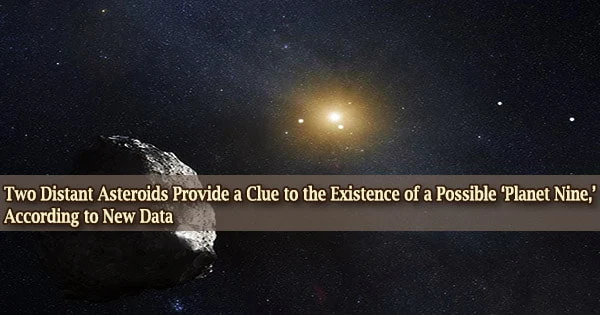The first of a new class of distant solar system objects, orbiting the Sun at a distance greater than that of Neptune, was discovered in the year 2000: the extreme trans Neptunian objects (ETNOs). In comparison to Earth, their orbits are relatively far from the Sun.
The ETNOs orbit the Sun at a distance of more than 150 astronomical units (1 AU, or 150 million kilometers). We orbit the Sun at a distance of one astronomical unit (1 AU, or 150 million kilometers).
Pluto’s orbit is roughly 40 AU, and its closest approach to the Sun (perihelion) is around 30 AU, to give you an indication of how far away they are. This finding marks a watershed moment in Solar System research, with 21 ETNOs discovered to date.
Several recent studies have proposed that the dynamical parameters of the ETNOs may be better explained if there were one or more planets orbiting the Sun at distances of hundreds of AU with masses several times that of Earth.
Brown and Batygin, for example, used the orbits of seven ETNOs to predict the existence of a “superearth” orbiting the sun at 700 AU in 2016. The sub-Neptunian mass range is named after this range of masses. This theory is known as the Planet Nine Hypothesis, and it is one of the most popular topics in planetary science right now.
Because the objects are so far away, the light they emit is quite feeble, and Sedna was the only one of the 21 trans Neptunian objects to be seen spectroscopically until today.
Now, a team of researchers led by the Instituto de Astrofisica de Canarias (IAC) and working in partnership with the Complutense University of Madrid has taken a step toward physical characterization of these entities in order to corroborate or disprove the Planet Nine idea.
The similar spectral gradients observed for the pair 2004 VN112 2013 RF98 suggests a common physical origin. We are proposing the possibility that they were previously a binary asteroid which became unbound during an encounter with a more massive object.
Julia de León
The scientists have performed the first spectroscopic observations of 2004 VN112 and 2013 RF98, two objects that are dynamically fascinating since their orbits are nearly identical and a slight angle separates their poles. This suggests that they share a similar ancestor, and their current orbits could be the result of a prior encounter with the fictitious Planet Nine.
This research, published in the Royal Astronomical Society’s Monthly Notices, shows that this pair of ETNOs was a binary asteroid that split apart after colliding with a planet outside Pluto’s orbit.
They used the first visible-range spectroscopic observations of 2004 VN112 and 2013 RF98 to arrive at these results. These observations were made in collaboration with support astronomers Gianluca Lombardi and Ricardo Scarpa, and they were made using the OSIRIS spectrograph on the Gran Telescopio CANARIAS (GTC) at the Roque de los Muchachos Observatory (Garafa, La Plama). Because of their immense distance, these asteroids appear to move very slowly in the sky, making identification difficult.
They then estimated their apparent magnitudes (brightness as seen from Earth) and reconstructed 2013 RF98’s orbit, which had previously been poorly known. They discovered this object at a distance of more than an arcminute from the ephemerides’ projected position.
The Minor Planet Center (MPEC 2016-U18: 2013 RF98), which is responsible for the detection of comets and minor planets (asteroids), as well as measurements of their parameters and orbital positions, has published these data, which helped to refine the computed orbit.
The visible spectrum can also reveal information about their make-up. It can be established if they have pristine ices on their surfaces, as Pluto does, or highly processed carbon compounds, by analyzing the slope of the spectra.
The spectrum can also reveal the existence of amorphous silicates, such as those found in Jupiter’s Trojan asteroids.
The photometric readings for two more ETNOs, 2000 CR105, and 2012 VP113, are nearly equal and close to those obtained for 2004 VN112 and 2013 RF98. Sedna, on the other hand, is the only one of these objects that has been spectroscopically detected before, and its values are substantially different from the others.
Except for Sedna, which is assumed to have come from the inner section of the Oort cloud, these five objects are part of a set of seven used to test the Planet Nine hypothesis, which argues that all of them should have a common origin.
“The similar spectral gradients observed for the pair 2004 VN112 2013 RF98 suggests a common physical origin,” explains Julia de León, the first author of the paper, an astrophysicist at the IAC. “We are proposing the possibility that they were previously a binary asteroid which became unbound during an encounter with a more massive object.”
To test this theory, the researchers ran thousands of numerical simulations to observe how the orbits’ poles might separate over time.
These models indicate that a potential Planet Nine, with a mass of 10 to 20 Earth masses orbiting the Sun at a distance of 300 to 600 AU, might have deviated the pair 2004 VN112 2013 RF98 between 5 and 10 million years ago.
This could explain, in theory, how these two asteroids, which began orbiting one another as a pair, progressively split in their orbits as they approached a considerably more massive object at a specific point in time.





